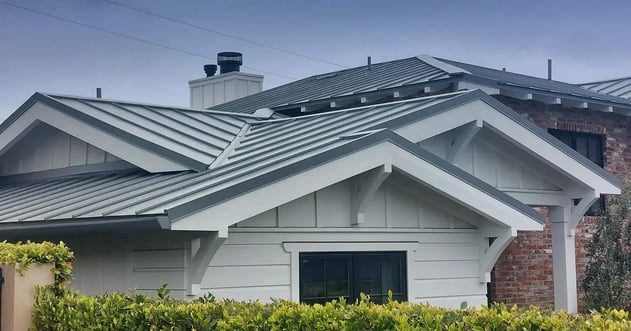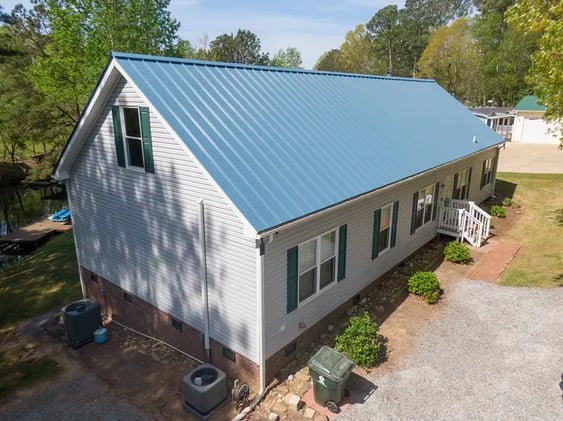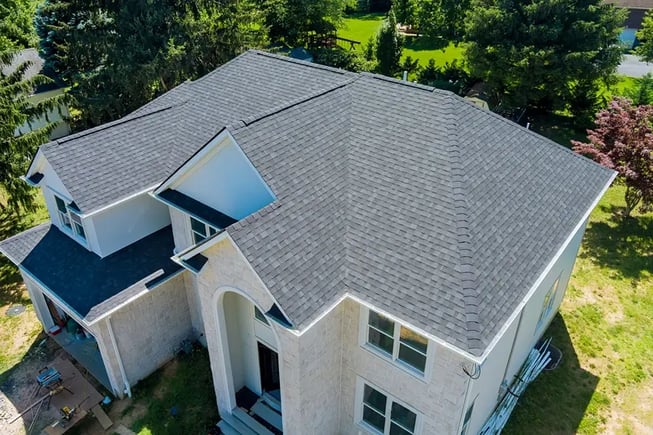When it comes to roofing, both shingles and metal offer their own set of advantages, leaving many people torn between the two. But despite metal roofing’s impressive durability and lifespan, shingles are still more popular.
Why?
Well, it all comes down to cost vs value. For the average homeowner, the extra durability of a metal roof just doesn't outweigh the additional cost. But if you're in your "forever home" or you just love the sleek modern look of metal, then this trendy option might be for you.
In this article we’ll break down all the costs and factors involved, so you can make the best choice for your home.
Metal Roofing vs. Shingles: A Quick Overview
Metal Roofing
Metal roofing has gained a lot of popularity in recent years, and for good reasons. It stands out for its durability, longevity, and versatility. Let’s dive deeper into what makes metal roofing a solid choice for many homeowners.
Durability and Longevity
- Built to Last: Metal roofs are incredibly durable and can last anywhere from 40 to 70 years, depending on the material and maintenance. This makes them one of the longest-lasting roofing materials available on the market.
- Weather-Resistant: Metal roofing holds up well against extreme weather conditions, including heavy rain, snow, hail, and high winds. It’s also fire-resistant, which adds an extra layer of protection to your home.
- Low Maintenance: Because metal roofs are less likely to crack, split, or suffer damage from elements like moss or mildew, they generally require less maintenance than other roofing options.
Types of Metal Roofing Materials
Metal roofing isn’t just one-size-fits-all. It comes in several different materials, each with its own benefits:
- Aluminum: Lightweight and corrosion-resistant, aluminum is an excellent choice for homes in coastal areas where saltwater exposure can be an issue. It’s also a relatively affordable option among metal roofing materials.
- Steel: One of the most common choices for metal roofing, steel is durable, strong, and often coated to prevent rust and corrosion. It’s available in galvanized or galvalume forms, providing a range of colors and finishes.
- Copper: Known for its beautiful appearance and patina that develops over time, copper roofing is a premium option. While it’s more expensive than other metals, it offers unmatched longevity, often lasting well over a century.
Shingles
Durability and Practicality
- Affordable and Accessible: Asphalt shingles are one of the most budget-friendly roofing materials available. They’re widely produced and easily accessible, which keeps the cost lower than most other roofing options.
- Moderate Lifespan: Shingles typically have a lifespan of 15 to 30 years, depending on the quality and type. While they don’t last as long as metal roofs, they still offer a decent duration for their price point.
- Easy Installation and Replacement: One of the major advantages of shingles is how easy they are to install. Most roofing professionals are familiar with shingle installation, and individual shingles can be replaced relatively easily if they get damaged.
Types of Shingles
While asphalt is the most common material, shingles come in a variety of types that offer different levels of durability and aesthetic appeal:
- 3-Tab Shingles: The most basic and affordable type of shingle. They have a flat, uniform look and are the least expensive option but also have the shortest lifespan.
- Architectural Shingles: Also known as dimensional or laminate shingles, these offer a more textured, layered look. They are thicker and more durable than 3-tab shingles, providing better longevity and improved resistance to wind and weather.
- Luxury Shingles: These are the top-tier option among asphalt shingles, designed to mimic the look of more expensive materials like slate or wood shake. While they come at a higher cost, they provide enhanced durability and a high-end appearance.
Choosing Between Metal Roofing and Shingles
Your choice between metal roofing and shingles largely depends on your priorities as a homeowner. If you're looking for a long-lasting, low-maintenance solution with excellent weather resistance, metal roofing might be the best choice for you. On the other hand, if you prefer a more affordable option with a classic look and don't mind periodic maintenance, shingles could be the way to go.
Metal Roofs vs Shingles Cost
Metal Roofing Costs
When considering metal roofing, the two most common options are standing seam and exposed fastener systems. Each type comes with different price points and characteristics that affect the overall cost of materials, installation, and long-term value.
Standing Seam Metal Roofing Costs

Standing seam metal roofing is known for its sleek, modern appearance and high durability. It features raised seams that interlock, providing superior weather resistance. Because of its complexity and the need for specialized installation, this type of roofing generally costs more upfront.
When combining materials and installation, you can expect to pay between $18.00 - $24.00 per square foot for a standing seam metal roof, depending on factors like roof complexity and geographic location. For a 1,700 square foot roof (the average in the United States), that brings you to $30,000 - $40,000 for the entire roof.
The higher cost of standing seam metal roofs is largely justified by their superior durability, minimal maintenance needs, and attractive appearance. They typically last 50 years or more, providing a long-term solution that might eliminate the need for another roof replacement in your lifetime.
Exposed Fastener Metal Roofing Costs

Exposed fastener metal roofing, also known as screw-down roofing, is a more affordable and straightforward option. It features visible screws that attach the panels directly to the roof deck, which makes the installation process faster and easier.
The overall cost of an exposed fastener roof typically ranges from $5-$7 per square foot, making it a much more budget-friendly option compared to standing seam roofing. That means an average exposed-faster roof will cost between $8,500 and $12,000.
While more affordable, exposed fastener roofs do come with some drawbacks, such as a higher risk of leaks due to the visible fasteners. These fasteners will loosen over time due to thermal expansion and contraction, leading to potential water damage if not maintained properly. Because of this expansion and contraction, you’ll need to replace the screws every 5 years or so.
Comparison of Long-Term Value
- Standing Seam: Although standing seam roofs come with a higher upfront cost, they generally offer better long-term value. They require less maintenance, have lower chances of leaks, and come with longer warranties. The concealed fasteners help protect against the elements, reducing the risk of leaks and extending the roof's lifespan.
- Exposed Fastener: Exposed fastener roofs may cost less initially, but they require more frequent maintenance to check and replace the fasteners. Their lifespan is typically shorter, around 20 years, and they may not come with the same level of warranty coverage due to their vulnerability to leaks and weather damage.
Asphalt Shingle Costs

Shingles remain the most commonly chosen roofing material in the U.S., largely because of their affordability and straightforward installation process. They typically cost between $12,000 and $16,000 total (for an average home).
Higher-end architectural or luxury shingles can push that cost to $20,000 or more, depending on the size and complexity of the roof.
Factors Influencing Shingle Costs
Several factors can affect the cost of shingle installation:
Shingle Type:
- 3-Tab Shingles: The most affordable option. They are thinner and less durable.
- Architectural Shingles: A more durable and aesthetically appealing option.
- Luxury Shingles: High-end shingles that mimic the look of slate or wood.
Roof Pitch: Steeper roofs require more safety measures and are more difficult to work on, which can increase labor costs.
Labor Rates: Similar to metal roofing, labor costs for shingle installation depend on the location and demand for roofing contractors in your area.
Shingles vs Metal Roofing Cost: The Upshot
Metal Roofing—particularly standing seam—comes with a higher upfront cost, ranging from $18 to $24 per square foot, translating to around $30,000 to $40,000 for an average-sized roof. However, its exceptional durability and low maintenance requirements mean it can last 50 years or more, often making it the last roof you'll ever need to install. In comparison, exposed fastener metal roofs are more affordable, typically costing between $5 to $7 per square foot or about $8,500 to $12,000 for the same roof size. Despite the lower initial expense, exposed fastener roofs have a shorter lifespan of around 15 to 20 years and require more frequent maintenance to manage potential leaks from the visible fasteners.
Shingles, on the other hand, are more budget-friendly than standing seam metal, but less than exposed fastener, with installation costs ranging from $12,000 to $16,000 for standard shingles and up to $20,000 or more for high-end varieties like architectural or luxury shingles.
Why Homeowners Typically Choose Shingles Over Metal Roofing
While metal roofing offers long-term durability and value, many homeowners still opt for shingles when it comes to their roofing needs. The reasons often boil down to cost, aesthetics, and familiarity, among other factors.
1. Lower Upfront Cost
One of the biggest reasons people choose shingles over metal roofing is the lower upfront cost. The average cost to install asphalt shingles ranges from $12,000 to $16,000 for a standard-sized roof, with luxury or architectural shingles going up to around $20,000. In contrast, metal roofing—especially standing seam systems—can range from $30,000 to $40,000 or more for the same size roof.
2. Cost vs. Value
Many homeowners see the value of shingles as more aligned with their budget and needs. While metal roofs provide greater durability and a longer lifespan, their high initial cost can be a barrier. Most people only stay in their homes for around 13 years on average, which is far less than the lifespan of a metal roof. Given this, the long-term value of metal roofing might not seem worth the investment if a homeowner plans to move before they can fully benefit from its durability.
In this context, shingles offer a more immediate return on investment. They provide a reasonable lifespan of 15 to 30 years, which aligns with the time many homeowners expect to stay in their homes, making them a more appealing short- to medium-term solution.
3. Ease of Installation and Repairs
Shingles are much easier to install and repair compared to metal roofing. Most roofing contractors are familiar with shingle installation, which means the process is faster and more straightforward. This ease of installation reduces labor costs and the overall time required to complete the project.
In the event of damage, replacing a few shingles is relatively simple and inexpensive, whereas repairing or replacing a section of metal roofing can be more complex and costly. The widespread availability of shingles and the familiarity most contractors have with this material make it a hassle-free choice for many homeowners.
4. Aesthetic Flexibility
Shingles also offer a wide range of colors, textures, and styles, which can be more appealing to homeowners looking to match their roof to their home’s exterior. While metal roofs are increasingly available in different colors and styles, some homeowners still prefer the traditional look of asphalt shingles, which blend more naturally with many residential architectural styles.
5. Noise and Thermal Performance Concerns
Metal roofs are known for their durability, but they can also be noisy during heavy rain or hail unless adequately insulated. For some homeowners, this is a significant drawback compared to shingles, which naturally dampen sound. Additionally, while metal roofs reflect heat and are more energy-efficient in hot climates, they can be less effective at insulating homes in colder regions, leading to potential increases in heating costs without proper insulation.
The Upshot
When choosing between metal roofs and shingles, the decision often comes down to your priorities in terms of cost, durability, and maintenance. While metal roofs, especially standing seam, demand a higher initial investment, they offer unmatched durability, often lasting 50 years or more with minimal upkeep. For those willing to invest in a long-term solution that requires little maintenance and provides excellent protection against the elements, metal roofing could be the best fit.
On the other hand, shingles remain the go-to option for many homeowners because of their lower upfront cost, ease of installation, and the familiar, traditional look they provide. Though they might not last as long as metal roofs, their affordability and quicker return on investment make them appealing for homeowners who plan to move within a couple of decades or prefer a classic aesthetic.
Ultimately, your choice will depend on your budget, how long you plan to stay in your home, and how much maintenance you're willing to handle. Both options have their own strengths, so consider your specific needs and priorities before making the decision. No matter what you choose, both metal and shingle roofing can provide reliable protection for your home for years to come.

